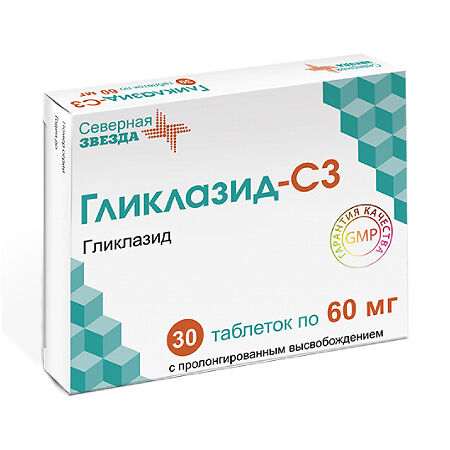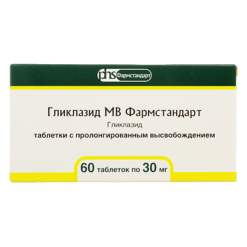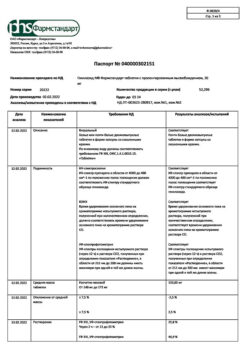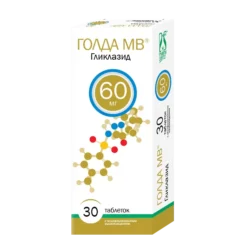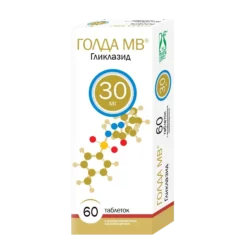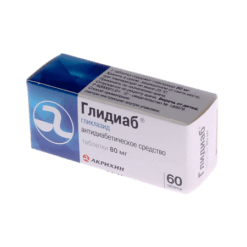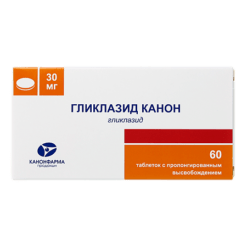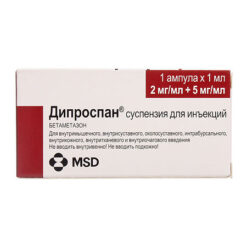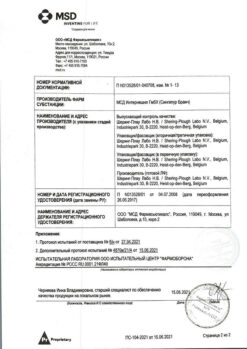No products in the cart.
Gliclazide-SZ, 60 mg 30 pcs
€4.16 €3.69
Description
Gliclazide is an oral sulfonylurea derivative hypoglycemic drug that differs from similar drugs by the presence of N-containing heterocyclic ring with endocyclic bonding.
Glyclazide reduces blood glucose concentration by stimulating insulin secretion by β-cells of Langerhans islets. Increased concentration of postprandial insulin and C-peptide persists after 2 years of therapy.
In addition to effects on carbohydrate metabolism, gliclazide has hemovascular effects.
The effect on insulin secretion
In type 2 diabetes, the drug restores the early peak of insulin secretion in response to glucose intake and increases the second phase of insulin secretion. Significant increase of insulin secretion is observed in response to stimulation caused by food intake or glucose administration.
Hemovascular effects
Glyclazid reduces the risk of small vessel thrombosis by affecting the mechanisms that can cause complications in diabetes: Partial inhibition of platelet aggregation and adhesion and decreased concentration of platelet activation factors (beta-thromboglobulin thromboxane B2) and on restoration of fibrinolytic activity of the vascular endothelium and increased tissue plasminogen activator activity.
Intensive glycemic control based on the use of prolonged-release gliclazide significantly reduces micro- and macrovascular complications of type 2 diabetes compared to standard glycemic control.
Pharmacokinetics:
Intake
After oral administration, gliclazide is completely absorbed. The plasma concentration of gliclazide increases gradually over the first 6 hours a plateau level is maintained from 6 to 12 hours. Individual variability is low.
Eating does not affect the rate or degree of absorption of gliclazide.
Distribution
About 95% of gliclazide is bound to blood plasma proteins. The volume of distribution is about 30 liters. Administration of Gliklazid-SZ at a dose of 60 mg once daily maintains the effective plasma concentration of gliklazide for more than 24 hours.
Metabolism
Glyclazide is metabolized predominantly in the liver. There are no active metabolites in blood plasma.
Elimation
Gliclaclazide is mainly excreted by the kidneys: less than 1% is excreted unchanged by the kidneys as metabolites. The elimination half-life of gliclazide is on average 12 to 20 hours.
Linearity
The relationship between the dose taken (up to 120 mg) and the area under the pharmacokinetic curve “concentration-time” is linear.
Particular populations
The elderly
There are no significant changes in pharmacokinetic parameters in the elderly.
Indications
Indications
Type 2 diabetes mellitus with insufficient effectiveness of diet therapy, physical activity and weight loss.
Prevention of diabetes complications: reducing the risk of microvascular (nephropathy retinopathy) and macrovascular complications (myocardial infarction, stroke) in patients with type 2 diabetes through intensive glycemic control.
Pharmacological effect
Pharmacological effect
Gliclazide is a sulfonylurea derivative, an oral hypoglycemic drug that differs from similar drugs by the presence of an N-containing heterocyclic ring with an endocyclic linkage.
Gliclazide reduces blood glucose concentrations by stimulating insulin secretion by β-cells of the islets of Langerhans. Increases in postprandial insulin and C-peptide concentrations persist after 2 years of therapy.
In addition to its effect on carbohydrate metabolism, gliclazide has hemovascular effects.
Effect on insulin secretion
In type 2 diabetes mellitus, the drug restores the early peak of insulin secretion in response to glucose and enhances the second phase of insulin secretion. A significant increase in insulin secretion is observed in response to stimulation caused by food intake or glucose administration.
Hemovascular effects
Gliclazide reduces the risk of thrombosis of small vessels by influencing the mechanisms that can cause the development of complications in diabetes mellitus: partial inhibition of platelet aggregation and adhesion and a decrease in the concentration of platelet activating factors (beta-thromboglobulin thromboxane B2), as well as restoration of fibrinolytic activity of the vascular endothelium and increased activity of tissue plasminogen activator.
Intensive glycemic control based on the use of extended-release gliclazide significantly reduces micro- and macrovascular complications of type 2 diabetes mellitus in comparison with standard glycemic control.
Pharmacokinetics:
Suction
After oral administration, gliclazide is completely absorbed. The concentration of gliclazide in the blood plasma increases gradually during the first 6 hours; the plateau level is maintained from 6 to 12 hours. Individual variability is low.
Food intake does not affect the rate or extent of absorption of gliclazide.
Distribution
Approximately 95% of gliclazide is bound to plasma proteins. Distribution volume – about 30 l. Taking the drug Gliclazide-SZ at a dose of 60 mg once a day ensures the maintenance of an effective concentration of gliclazide in the blood plasma for more than 24 hours.
Metabolism
Gliclazide is metabolized primarily in the liver. There are no active metabolites in blood plasma.
Removal
Gliclazide is excreted mainly by the kidneys: excretion occurs in the form of metabolites; less than 1% is excreted unchanged by the kidneys. The half-life of gliclazide averages from 12 to 20 hours.
Linearity
The relationship between the dose taken (up to 120 mg) and the area under the concentration-time pharmacokinetic curve is linear.
Special populations
Elderly people
In elderly people, no significant changes in pharmacokinetic parameters are observed.
Special instructions
Special instructions
Hypoglycemia
When taking sulfonylurea derivatives, including gliclazide, hypoglycemia may develop in some cases – in a severe and prolonged form requiring hospitalization and intravenous administration of a dextrose solution for several days (see section “Side Effects”).
The drug can be prescribed only to those patients whose meals are regular and include breakfast. It is very important to maintain a sufficient intake of carbohydrates from food, since the risk of developing hypoglycemia increases with irregular or insufficient nutrition, as well as when consuming foods low in carbohydrates.
Hypoglycemia is more likely to occur when eating a low-calorie diet, following prolonged or vigorous exercise, drinking alcohol, or when taking multiple hypoglycemic medications at the same time.
As a rule, the symptoms of hypoglycemia disappear after eating a meal rich in carbohydrates (for example, sugar). It should be borne in mind that taking sweeteners does not help eliminate hypoglycemic symptoms. Experience with other sulfonylureas suggests that hypoglycemia may recur despite initial effective management of the condition.
If hypoglycemic symptoms are pronounced or long-lasting, even in the case of a temporary improvement in the condition after eating a meal rich in carbohydrates, emergency medical care is necessary, including hospitalization.
To avoid the development of hypoglycemia, careful individual selection of drugs and dosage regimen is necessary, as well as providing the patient with complete information about the treatment being carried out. An increased risk of hypoglycemia may occur in the following cases:
– refusal or inability of the patient (especially the elderly) to follow the doctor’s prescriptions and control their condition;
– insufficient and irregular nutrition, skipping meals, fasting and changes in diet;
– imbalance between physical activity and the amount of carbohydrates taken;
– renal failure;
– severe liver failure;
– overdose of the drug Gliclazide-SZ;
– some endocrine disorders: diseases of the thyroid gland, pituitary and adrenal insufficiency;
– simultaneous use of certain medications (see section “Interaction with other medications”).
Kidney and liver failure
In patients with hepatic and/or severe renal impairment, the pharmacokinetic and/or pharmacodynamic properties of gliclazide may be altered. The state of hypoglycemia that develops in such patients can be quite long-lasting; in such cases, immediate appropriate therapy is necessary.
Insufficient glycemic control
Glycemic control in patients receiving therapy with hypoglycemic agents may be weakened in the following cases: fever, trauma, infectious diseases or major surgical procedures. In these conditions, it may be necessary to stop therapy with Gliclazide-SZ and prescribe insulin therapy.
In many patients, the effectiveness of oral hypoglycemic agents, including gliclazide, tends to decrease after a prolonged period of treatment. This effect may be due to both progression of the disease and a decrease in the therapeutic response to the drug.
This phenomenon is known as secondary drug resistance, which must be distinguished from primary resistance, in which the drug does not give the expected clinical effect even at the first prescription. Before diagnosing secondary drug resistance in a patient, it is necessary to assess the adequacy of dose selection and the patient’s compliance with the prescribed diet.
Laboratory tests
To assess glycemic control, regular determination of fasting blood glucose and glycated hemoglobin HbAlc is recommended. In addition, it is advisable to regularly self-monitor blood glucose concentrations.
Sulfonylureas may cause hemolytic anemia in patients with glucose-6-phosphate dehydrogenase deficiency. Since gliclazide is a sulfonylurea derivative, caution must be exercised when prescribing it to patients with glucose-6-phosphate dehydrogenase deficiency. The possibility of prescribing a hypoglycemic drug of another group should be assessed.
Patient Information
It is necessary to inform the patient and his family members about the risk of developing hypoglycemia, its symptoms and conditions conducive to its development. The patient must be informed of the potential risks and benefits of the proposed treatment.
The patient must be explained the importance of diet, regular exercise, and monitoring blood glucose concentrations.
Impact on the ability to drive vehicles. Wed and fur.:
Active ingredient
Active ingredient
Gliclazide
Composition
Composition
One tablet contains:
active ingredient: gliclazide – 60 mg
excipients:
calcium hydrogen phosphate dihydrate – 53.5 mg;
maltodextrin – 15.0 mg;
hypromellose 4 K M (hydroxypropyl methylcellulose) – 4.3 mg;
hypromellose K 100 LV (hydroxypropyl methylcellulose) – 25.7 mg;
colloidal silicon dioxide anhydrous (aerosil anhydrous) – 0.5 mg;
magnesium stearate – 1.0 mg.
Pregnancy
Pregnancy
Pregnancy
There is no experience with the use of gliclazide during pregnancy. Data on the use of other sulfonylureas during pregnancy are limited.
In studies on laboratory animals, no teratogenic effects of gliclazide were identified.
To reduce the risk of developing congenital defects, optimal control (appropriate therapy) of diabetes mellitus is necessary. Oral hypoglycemic drugs are not used during pregnancy. Insulin is the drug of choice for the treatment of diabetes mellitus in pregnant women. It is recommended to replace the intake of oral hypoglycemic drugs with insulin therapy both in the case of a planned pregnancy and in the event that pregnancy occurs while taking the drug.
Breastfeeding period
Taking into account the lack of data on the entry of gliclazide into breast milk and the risk of neonatal hypoglycemia during drug therapy, breastfeeding is contraindicated.
Contraindications
Contraindications
Hypersensitivity to gliclazide, other sulfonylurea derivatives, sulfonamides or excipients included in the drug;
type 1 diabetes mellitus;
diabetic ketoacidosis diabetic precoma diabetic coma;
severe renal or liver failure (in these cases it is recommended to use insulin);
taking miconazole (see section “Interaction with other drugs”);
pregnancy and breastfeeding (see section “Use during pregnancy and breastfeeding”);
age up to 18 years.
It is not recommended to use in combination with phenylbutazone or danazol (see section “Interaction with other drugs”).
With caution:
Older age, irregular and/or unbalanced diet, glucose-6-phosphate dehydrogenase deficiency, severe diseases of the cardiovascular system, hypothyroidism, adrenal or pituitary insufficiency, renal and/or liver failure, long-term therapy with glucocorticosteroids (GCS), alcoholism.
Side Effects
Side Effects
Taking into account the experience with the use of gliclazide, one should be aware of the possibility of developing the following side effects.
Hypoglycemia
Like other sulfonylurea drugs, Gliclazide-SZ can cause hypoglycemia if meals are not taken regularly and especially if meals are missed. Possible symptoms of hypoglycemia: headache, severe hunger, nausea, vomiting, increased fatigue, sleep disturbance, irritability, decreased concentration, slow reaction time, depression, confusion, blurred vision and speech, aphasia, tremors, paresis, loss of self-control, a feeling of helplessness, impaired perception, dizziness, weakness, convulsions, bradycardia, delirium, shallow breathing, drowsiness, loss of consciousness with the possible development of coma, even death.
Adrenergic reactions may also be observed: increased sweating, “sticky” skin, anxiety, tachycardia, increased blood pressure, palpitations, arrhythmia and angina. As a rule, the symptoms of hypoglycemia are relieved by taking carbohydrates (sugar). Taking sweeteners is ineffective. Against the background of other sulfonylurea derivatives, relapses of hypoglycemia were observed after its successful relief.
In case of severe or prolonged hypoglycemia, emergency medical care is indicated, possibly with hospitalization, even if there is an effect from taking carbohydrates.
Other side effects
From the gastrointestinal tract: abdominal pain, nausea, vomiting, diarrhea, constipation. Taking the drug during breakfast can avoid or minimize these symptoms.
The following side effects are less common:
From the skin and subcutaneous tissue: rash itching urticaria angioedema erythema maculopapular rash bullous reactions (such as Stevens-Jones syndrome and toxic epidermal necrolysis).
From the hematopoietic organs and lymphatic system: hematological disorders (anemia, leukopenia, thrombocytopenia, granulocytopenia) rarely develop. As a rule, these phenomena are reversible if therapy is discontinued.
From the liver and biliary tract: increased activity of liver enzymes (aspartate aminotransferase (ACT), alanine aminotransferase (ALT), alkaline phosphatase) hepatitis (isolated cases). If cholestatic jaundice appears, therapy should be discontinued.
These effects are usually reversible if therapy is discontinued.
On the part of the organ of vision: transient visual disturbances may occur caused by changes in blood glucose concentrations, especially at the beginning of therapy.
Side effects inherent in sulfonylurea derivatives: as with the use of other sulfonylurea derivatives, the following side effects were noted: erythrocytopenia agranulocytosis hemolytic anemia pancytopenia allergic vasculitis hyponatremia. There was an increase in the activity of liver enzymes, impaired liver function (for example, with the development of cholestasis and jaundice) and hepatitis; manifestations decreased over time after discontinuation of sulfonylurea drugs, but in some cases led to life-threatening liver failure.
Interaction
Interaction
Drugs and substances that increase the risk of hypoglycemia: (increasing the effect of gliclazide)
Contraindicated combinations
– Miconazole (with systemic administration and when using the gel on the oral mucosa): enhances the hypoglycemic effect of gliclazide (possible development of hypoglycemia up to the state of coma).
Not recommended combinations
– Phenylbutazone (systemic administration): enhances the hypoglycemic effect of sulfonylurea derivatives (displaces them from association with plasma proteins and/or slows down their elimination from the body).
It is preferable to use another anti-inflammatory drug. If taking phenylbutazone is necessary, the patient should be warned about the need for glycemic control. If necessary, the dose of Gliclazide-SZ should be adjusted while taking phenylbutazone and after its termination.
– Ethanol: enhances hypoglycemia by inhibiting compensatory reactions and may contribute to the development of hypoglycemic coma. It is necessary to stop taking medications that contain ethanol and drinking alcohol.
Combinations requiring precautions
Taking gliclazide in combination with certain medications: other hypoglycemic agents (insulin, acarbose, metformin, thiazolidinediones, dipeptidyl peptidase-4 inhibitors, GLP-1 agonists); beta-blockers fluconazole; angiotensin-converting enzyme inhibitors – captopril enalapril; H2-histamine receptor blockers; monoamine oxidase inhibitors; sulfonamides; clarithromycin and non-steroidal anti-inflammatory drugs) is accompanied by an increased hypoglycemic effect and the risk of hypoglycemia.
Drugs that increase blood glucose levels: (weakening the effect of gliclazide)
Not recommended combinations
– Danazol: has a diabetogenic effect. If the patient needs to take this drug, careful monitoring of blood glucose is recommended. If it is necessary to take drugs together, it is recommended to select the dose of a hypoglycemic agent both while taking danazol and after its discontinuation.
Combinations requiring precautions
– Chlorpromazine (neuroleptic): in high doses (more than 100 mg per day) increases the concentration of blood glucose by reducing insulin secretion. Careful glycemic control is recommended. If it is necessary to take drugs together, it is recommended to select the dose of a hypoglycemic agent both while taking the antipsychotic and after its withdrawal.
– GCS (systemic and local use: intra-articular dermal rectal administration) and tetracosactide: increase the concentration of blood glucose with the possible development of ketoacidosis (decreased tolerance to carbohydrates). Careful glycemic control is recommended, especially at the beginning of treatment. If it is necessary to take drugs together, it may be necessary to adjust the dose of the hypoglycemic agent both while taking GCS and after their withdrawal.
– Ritodrine salbutamol terbutaline (intravenous administration): beta-2 adrenergic agonists increase blood glucose concentrations.
Particular attention should be paid to the importance of self-glycemic control. If necessary, it is recommended to transfer the patient to insulin therapy.
Combinations to be taken into account
Anticoagulants (eg warfarin)
Sulfonylurea derivatives may enhance the effect of anticoagulants when taken together. Anticoagulant dose adjustment may be required.
Overdose
Overdose
In case of overdose with sulfonylurea derivatives, hypoglycemia may develop.
If moderate symptoms of hypoglycemia occur without impairment of consciousness or neurological symptoms, you should increase your intake of carbohydrates with food, reduce the dose of the drug and/or change your diet. Close medical monitoring of the patient’s condition should continue until it is certain that nothing threatens his health.
The development of severe hypoglycemic conditions accompanied by coma, seizures or other neurological disorders is possible. If such symptoms appear, emergency medical care and immediate hospitalization are necessary.
In case of hypoglycemic coma or if it is suspected, the patient is injected intravenously with 50 ml of a 20-40% dextrose (glucose) solution. Then a 5-10% dextrose solution is administered intravenously to maintain the blood glucose concentration above 1 g/l. Careful monitoring of blood glucose levels and observation of the patient should be carried out for at least the next 48 hours. After this period of time, depending on the patient’s condition, the attending physician decides on the need for further observation.
Dialysis is ineffective due to the pronounced binding of gliclazide to plasma proteins.
Storage conditions
Storage conditions
In a place protected from light at a temperature not exceeding 25 ° C.
Keep out of the reach of children.
Shelf life
Shelf life
3 years.
Manufacturer
Manufacturer
North Star NAO, Russia
Additional information
| Shelf life | 3 years. |
|---|---|
| Conditions of storage | In the dark place at a temperature not exceeding 25 °С. Store out of the reach of children. |
| Manufacturer | North Star NAO, Russia |
| Medication form | sustained release tablets |
| Brand | North Star NAO |
Other forms…
Related products
Buy Gliclazide-SZ, 60 mg 30 pcs with delivery to USA, UK, Europe and over 120 other countries.

